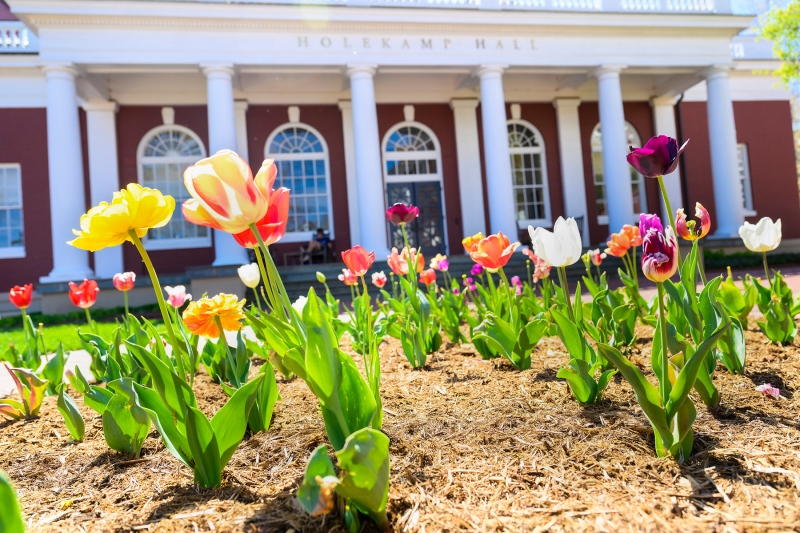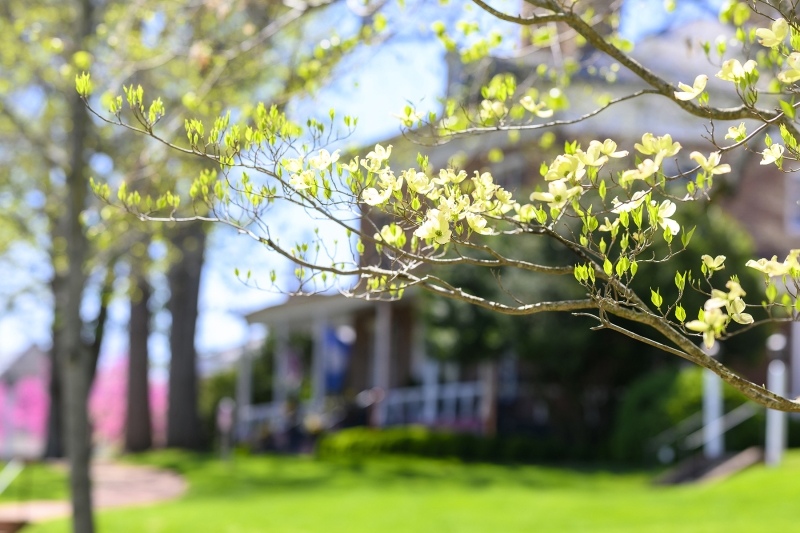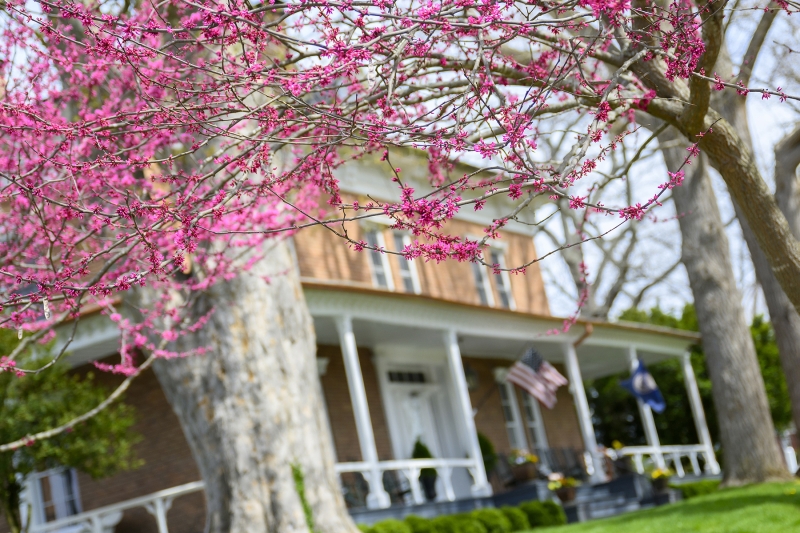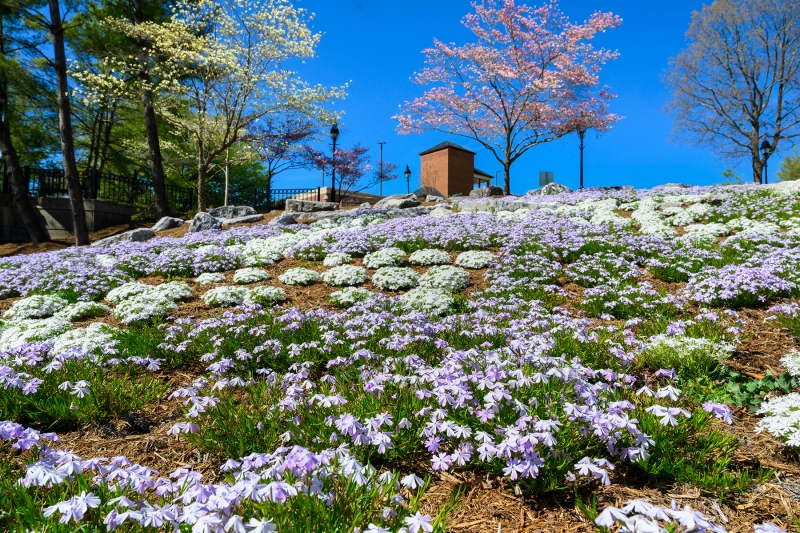W&L in Full Bloom Washington and Lee’s campus is thriving thanks to the hard work and dedication of a team that collaborates with Mother Nature year-round.
“The appearance of the campus grounds can help contribute to enrollment of students, employment of faculty and staff, and the overall experience of visitors and returning alumni.”
~ Tom Kalasky, executive director of University Facilities
Washington and Lee’s campus is abuzz with activity, but this time it’s not the students! As the landscape awakens from the winter months, trees and flowers are beginning to bloom, inviting the campus community and visitors to venture outside and enjoy the beauty that’s emerging all across campus. Less visible is the time, planning and dedication of the team who keeps W&L’s campus picturesque year-round.
The W&L grounds crew works through all four seasons to maintain the cycle of planting necessary for flowers and plants to flourish. The team consists of 17 team members, including grounds crew supervisor Nick Yakish, who holds a master’s degree in Environmental Management and was most recently the head agronomist at Arlington National Cemetery, making him well-versed in the thoughtful preservation of historic grounds and landscaping.
“With Nick here, we’re making better choices about what we put in as far as plantings,” said Mike Minnick, director of operations and maintenance for W&L University Facilities. “We’re making sure it’s going to last.”
Yakish’s team does landscape installations in partnership with a local landscape design firm, and one of their most recent projects included new plantings and landscape design surrounding the Admissions office, with a particular emphasis on merging the landscaping with plantings adjacent to the new Center for Global Learning. For this project, the team was able to ensure that 80% of the plants used were native plantings, which play an important role in supporting the local ecosystem. These plants also adapted to the region’s climate and soil conditions better than non-native species, making them a sustainable and pollinator-friendly option for creating a good first impression with prospective students and their families.
Many more of the team’s projects are cyclical. The grounds crew planted over 2,000 bulbs in the fall to bloom this spring, and spread more than 50 tons of topsoil across campus. Mike Moore, the W&L grounds crew’s longest-serving team member with over 35 years of service, said two full months of mulching flower beds around campus are needed in the spring to prepare for large campus events, such as reunions and commencement exercises.
Campus visitors will also notice new plantings of purple creeping phlox, a hardy groundcover native to the area, on the corner of Washington and Nelson streets. The team planted over 1,000 phlox plants last winter to achieve its current state.
“My crew works hard, often in adverse conditions — they’re really the cornerstone of the operation,” Yakish said.
Brandy Murphy, W&L’s campus gardener, said the next few weeks present an energizing opportunity to refresh pots and planters on campus with new annuals that will be cared for throughout the summer. Murphy spent a recent morning adding cora bells, calla lilies and pansies to the memorial garden surrounding the historical marker between Chavis and Tucker Halls that commemorates enslaved people who worked on the university’s campus from the mid-1830s to the late 1850s.
Additionally, Murphy has planted drought-tolerant sedum and ice plants, which bloom daily at sunrise, around Liberty Hall Ruins to enhance the beauty of the historic structure. She also looks for opportunities to plant flowers such as delphinium and lithadora, along with white flowers of many varieties, to create pockets of W&L school colors on campus. While much of her time is spent planting and maintaining annual flowers around campus, Murphy said the university’s approach to landscape design incorporates a balance of perennials and annuals to keep the campus looking vibrant throughout the year.
“With perennials, you give up the length of the bloom for the longevity of the plant. Annuals will bloom longer but they don’t come back,” said Murphy, who also oversees the gardens surrounding Belfield, a guest house and special events venue for W&L.
This year, Belfield will be included for the first time in the Garden Club of Virginia’s Historic Garden Week tour on April 22. University Facilities meets several times a year with a representative from the Garden Club of Virginia’s Restoration Committee to review ongoing maintenance of the area directly adjacent to University Chapel, and will be working with a Garden Club landscape architect on the future restoration of the original landscape design and planting surrounding the chapel.
Throughout its yearly cycle of caring for the campus environment, University Facilities also makes efforts to imbue sustainability and energy efficiency into its practices. Leaves collected in the fall are donated to Boxerwood Garden and Nature Center to provide compost for their plantings. The crew also reuses the stripped mulch from beds to mix the much-needed organic matter into the topsoil used to nourish future plantings on campus, and wood chips that are left over from tree-trimming projects around campus are reused in W&L’s Campus Garden.
Jane Stewart, director of Sustainability, cited the rain garden near the Hillel House as an example of sustainable landscape and hardscape that provides both beauty and function.
“There are all kinds of pockets on campus like this where the grounds crew has done really interesting, innovative, especially sustainable things that I think are not obvious to everybody,” Stewart said.
The garden is designed with chutes that drain rainwater during downpours and disperse it to water plants in the rain garden.
“When it rains, the water is slowed down and dispersed over this area in a lovely, incredibly peaceful way,” Stewart continued, “and you can very clearly see that nature-designed landscape works, absorbing the water into the landscape before it gets to the hardscape so it’s not running off into the road or flooding the sewer. It just looks like a nice little seating area but was designed very thoughtfully to help this specific environmental issue.”
The planting beds in front of Leyburn Library are also an example of sustainable campus beauty. These beds are green roofs that cover utility bunkers, housing steam pipes, hot water converters and electrical equipment. The planted areas help insulate those spaces and manage water run-off from heavy rain.
“Our grounds team meets the challenge of managing unpredictable variables such as living plants and various environmental conditions to create and maintain high-quality campus landscape aesthetics, which influences first impressions,” said Tom Kalasky, executive director of University Facilities. “The appearance of the campus grounds can help contribute to enrollment of students, employment of faculty and staff, and the overall experience of visitors and returning alumni.”
Keep an eye on Scene on Campus to enjoy more of W&L’s campus in bloom this spring (and year-round), and don’t miss the slideshow below for campus beauty by the numbers.
 Flowers blooming in front of Holekamp Hall.
Flowers blooming in front of Holekamp Hall. Dogwood blooms on the Colonnade.
Dogwood blooms on the Colonnade. Redbuds line the sidewalk near the President’s House.
Redbuds line the sidewalk near the President’s House. Creeping phlox blooms behind the Richard L. Duchossois Athletic and Recreation Center.
Creeping phlox blooms behind the Richard L. Duchossois Athletic and Recreation Center.
You must be logged in to post a comment.